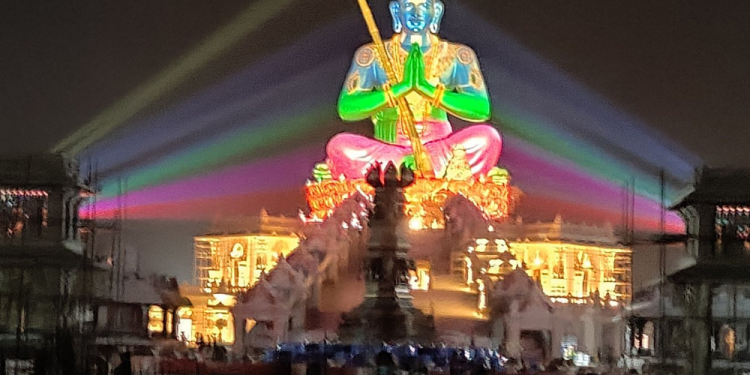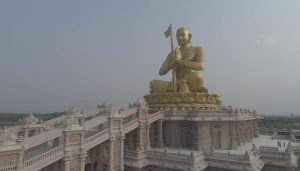In a country where statues with technology sophistication contribute to counting ‘tall’ (s)takes, this might not surprise many; however, it does ‘sit out on high’ and strong pedestal of spiritual socialism powered by a spatial technology. In the process, it does score a few firsts and seconds contributing to technology tourism even as it seeks to elevate and unite people’s thinking. That’s the Samatha Murthy – or the Statue of Equality – a 216-feet tall sitting statue of 11th century saint Ramanuja.
A huge sculptural ensemble that the statue is, in reality, the high-profile place is also a space of high technology stakes for audio-visual domain.
SI Asia tries to get the tech spades that made the modern abode of the saint.
………………………………………………………..
By RAM BHAVANASHI
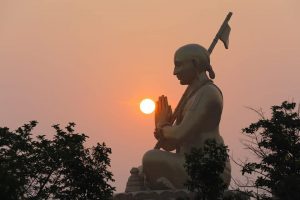 When India’s Prime Minister Narendra Modi unveiled on 5 Feb the Samatha Murthy – or the ‘Statue of Equality’ – at Muchintal, on the outskirts of Hyderabad, the capital of Telangana State, India, it was not an unveiling of a regulation statue. It was rather a special event of reckoning for people in general, and technology professionals in particular.
When India’s Prime Minister Narendra Modi unveiled on 5 Feb the Samatha Murthy – or the ‘Statue of Equality’ – at Muchintal, on the outskirts of Hyderabad, the capital of Telangana State, India, it was not an unveiling of a regulation statue. It was rather a special event of reckoning for people in general, and technology professionals in particular.
It was an event of a massive scale- both for the structure and texture; for people, processes, and the products that went into making it. A snappy outline of the project itself is looks tall:
Structure:
- Total 216-feet high sitting statue (second only to the world’s tallest sitting Buddha in Thailand)
- 108-feet high, 700 tonne-pancha loha (five metals of gold, silver, copper, brass and zinc) statue of Ramanuja- the Vaishnava bhakti saint from 11th century
- 27-feet lotus seat for the saintly statue to sit
- 54-feet, three-storey Bhadra Vedi below the lotus seat of the statue
- 108 Divya Deshams (replicas of 108 holy shrines characterizing India’s spiritual fabric)
- 120-kg gold statue of saint Ramanuja, symbolizing 120 years of his living on earth
Texture:
- A digital library with material on Vedic literature and explanations
- A research centre for Vedic studies, and a gallery on the life and preaching of the saint
- An auditorium/seminar hall for meetings
- An Omnimax theatre to hold various shows

- Ultra-modern facilities for visitors, tourists
Technology:
- A permanent sound and light show (intelligent lighting)
- Laser show, and 3D projection mapping
- Immersive audio, for the projection mapping and exterior areas
- Multilingual translation provision in the gallery
Spread over 45 acres of land at Muchintal – the base of Chinna Jeeyar Swamiji ashram – the project is one of the most premium projects with ₹ 1000 crore (US$130 million approx.) overall budget- with the entire funding coming from devotees across the world.
Bengaluru-headquartered T2 Consulting – known for such projects – landed the technology design consultancy while Gurugram-based systems integrator Tricolor India Schauspiel Pvt Ltd – who made quite a big name projection mapping expertise – won the intensely fought-bid for the integration job.
 “It was a very rigorous selection process wherein Swamiji himself was involved,” recalls Garima Mishra, Managing Director of Tricolor India. “We had to go through 2-3 rounds bidding screening, along with a few other national and international frontrunners in the field,” she explains. “We also did a live demonstration onsite with mock ups to visualize for the project owners how the finished project would like like.”
“It was a very rigorous selection process wherein Swamiji himself was involved,” recalls Garima Mishra, Managing Director of Tricolor India. “We had to go through 2-3 rounds bidding screening, along with a few other national and international frontrunners in the field,” she explains. “We also did a live demonstration onsite with mock ups to visualize for the project owners how the finished project would like like.”
Experience of over a decade, working with heritage, and protected monuments, UNESCO world heritage sites, and sites of historical and religious significance, presented them with the depth and width of expertise required for the kind of task at the Statue of Equality.
Eventually, Tricolor won the prestigious-yet-challenging project. The essential brief from the client was to create a spell-binding spectacle of projection mapping highlighting the life and preechings of the 11th century saint.
“An important spec of the brief was to deliver bright and intensely colorful images on the statue’s surface and to display captivating imagery on the gates and walls surrounding the statue.”
That the very nature of the project was like a heritage venue, with almost the entire stretch of structural elements having been built as per ‘aagama shastras’ (treatises on temple building guidelines) it place posed challenges of its size and scale.
“There were many challenges,” Garima asserts. “The very first one being working around the fixed ‘sthaapatya’ or the architecture of the building. We couldn’t project from the front because of the grand staircase and the fountain etc.; the other being that the statue is in bright golden shine, therefore making any projection on its surface highly challenging.”
They had to go back to drawing board a few times. Placement of projectors, the lensing, working within the architecture guidelines were truly challenging. It demanded an expertise of deep exposure to such tasks.
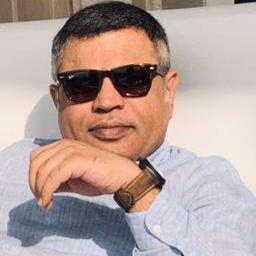 Says Tricolor’s Creative Director Himanshu Sabharwal: “Instead of frontal projection that is normal for all mapping installs, , we went to the sides- the projectors were mounted in a very intelligent way; neatly tucked away inside the entrance arches so that they are not noticeable even in daylight too.”
Says Tricolor’s Creative Director Himanshu Sabharwal: “Instead of frontal projection that is normal for all mapping installs, , we went to the sides- the projectors were mounted in a very intelligent way; neatly tucked away inside the entrance arches so that they are not noticeable even in daylight too.”
That wasn’t just one, he explains further. The throw distance was huge. The entry had to be moved a little further as if it had been even 10 metres more, we would have had to go with a customised lens.”
According to the two Tricolor-leading execs, the systems are their last available lens currently. That’s a key take.
Adding to this challenge, was the concern that how does the projection will work on the golden and shiny statue surface. However, they had the choice of projectors that are brilliant in terms of colour fidelity.
The task was accomplished using eight Crimson Series laser projectors and four Griffyn 4K32-RGB pure laser projectors. The Crimson Series projectors were tucked into two towers to deliver bright and intensely colorful images on the statue’s surface, while the Griffyn 4K32-RGB projectors were deployed on the gates and walls surrounding the statue to display captivating imagery.
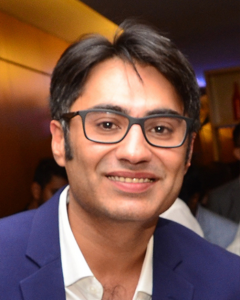 Chips in Rishubh Nayyar, Director at Christie Digital Systems India with pride: “This is the first time the Griffyn 4K32-RGB projectors have been utilized for a permanent installation in India. It’s a great honour for us to have been chosen to illuminate the Statue of Equality.”
Chips in Rishubh Nayyar, Director at Christie Digital Systems India with pride: “This is the first time the Griffyn 4K32-RGB projectors have been utilized for a permanent installation in India. It’s a great honour for us to have been chosen to illuminate the Statue of Equality.”
Audio, of similar measure:
While it is construed audio wouldn’t that a critical challenge as that of video, a venue like the Statue of Equality, given its temple-style architectural elements, open and vast spaces had its own challenges.
The audio systems coming from Bose Professional, were supplied by Anixter Distribution, and deployed through their integration partner Avils Infra Private Limited.
Understandably, the venue required a high-fidelity sound system that could reproduce a recorded track just like the original. Also, the loudspeakers were not to tamper with the aesthetic and heritage architectural appeal of the structure.
It was a matter of material and time for the audio people. They had roughly two months to ship the material and facilitate the installation.
 Says Vibhor Khanna, Anixter’s Vice-President for APAC: “The first challenge was ensuring availability of required material. Second was that by the time Avils got the order, the site was already in an advanced stage, so laying cables in some areas was difficult.”
Says Vibhor Khanna, Anixter’s Vice-President for APAC: “The first challenge was ensuring availability of required material. Second was that by the time Avils got the order, the site was already in an advanced stage, so laying cables in some areas was difficult.”
The site used stone as ceiling material to give it a heritage look, which made installing speakers and pulling wire challenging.
Anixter had to ensure the system design met the performance parameters of uniform coverage, appropriate SPL and STI. They worked closely with the A/V consultant, as well as their install partner to ensure everything was in sync- from design, procurement, and install to commission.
“We used delayed ring configuration to ensure that the outside seating area had uniform coverage and appropriate loudness,” explains Vibhor. “This resulted in uniform SPL and STI across the audience area.”
According to him, the modeling techniques provided by Anixter’s TSS team was critical to the design. The audio design therefore comprised a combination of Bose FreeSpace ceiling mount, environmental surface mount; Bose DesignMax and weather-rated Bose Arenamatch loudspeakers, along with Bose PowerMatch amplifiers, and Bose Control Space EX digital signal processor.
“All said and done, we were able to accomplish the task amidst challenges of very different kind,” sums up Vibhor.
Apparently, the solution providers strived hard to live up the requirement of the client- the Ashram administration, and their expert advisory body, led by Chinna Jeeyer Swamiji himself.
A truly landmark project for every stakeholder there.











